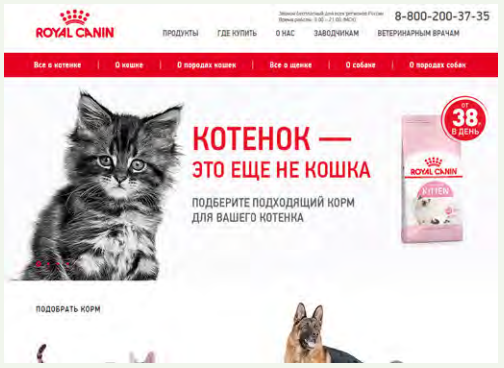3.11: Case study - Royal Canin Russia
- Page ID
- 36850
One-line summary
Royal Canin used existing data to create personalised email coupons and local offers tailored to individual subscribers, tapping into the love pet owners have for their unique animals.
The challenge
Royal Canin’s customer database was very outdated, and most people still bought their products in stores rather than online, a more efficient channel. Loyalty programmes for pets were usually seen as retailer initiatives rather than giving the brand recognition for these.
They wanted to create a loyalty programme that would encourage an image of Royal Canin as an expert in the field of pet food, across different breeds and it wanted to establish a relationship with consumers that would cause them to buy their pet food directly from the brand rather than at stores.
The solution
Royal Canin targeted dog and cat owners in the top six Russian cities, regardless of breed. They ran an algorithmic analysis of their CRM platform so that they could segment their audience and send offers according to:
- Type of pet
- Size of pet
- Upcoming ‘events’ such as a birthday or growth stage
- Medical records and any other data they had on the pet owner.
They could then send personalised email coupons to owners with deadlines for redemption. The unique link in the coupon would send the owner to a page already populated with a list of products chosen specifically for their pet, where they could place an order without leaving the platform. The online orders also facilitated brand communication by connecting pet owners to special events and programmes in various cities.

Customers could choose whether they wanted the food delivered to their home or whether they wanted to pick up their merchandise at a store near them.
Data from the mailed coupons was loaded into the CRM database, including whether the recipient used the coupons they were sent. The regular database updates helped the team assess a customer’s level of involvement with the platform.
It also affected the everyday aspects of the business. Based on coupon redemption and other information gleaned from the campaign, the brand could adjust the availability of items in online and offline retail platforms according to demand. It also gave them the data needed to understand how much inventory they needed for different products based on their popularity.
The results
The campaign was a resounding success. Because of the data-focused approach, Royal Canin:
- Reduced logistics costs
- Minimised waiting time for orders
- Improved the customer experience
- Showed the customer that the order was implemented by the brand and not a retail store
- Created an adaptive platform for mobile orders after finding that 80% of recipients opened the initial offer on mobile.
The campaign also worked very well for consumers.
- Push SMS messages sent using geolocation helped monitor special offers at retail stores. Subscribers in the area could then receive unique promotional codes to redeem at those stores
- 65% of respondents opened the campaign messages
- 74% of those who opened the message went to the online ordering platform
- 46% of orders implemented coupons
- 75% of customers participating in the programme said they used Royal Canin food for their pets.
(Digital Training Academy, 2017)
You can view the video for this campaign here: www.digitaltrainingacademy.com/casestudies/2017/02/mobile_case_study_royal_canin_runs_offers_ factory_for_pets_in_russia.php


